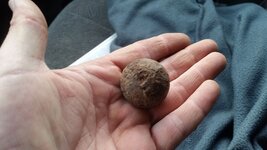Icewing
Silver Member
- Jan 5, 2016
- 2,633
- 5,494
- Detector(s) used
- Minelab Equinox 900 / Garrett PropointerAT.
- Primary Interest:
- All Treasure Hunting
I've been working with the local military park and the regional archeologists. We've been out all week detecting their hiking trails. I even got to dig my first big chunk of exploded cannonball. Fun stuff.
Anyway on to the topic at hand. At one of the places I've been detecting the property owner showed me this iron ball that he found somewhere there on the property. He also said they found a large cannon ball with a big hole (fuse hole). Here's where things get screwy and I even took it into the military park and showed it to them. All of them quickly said it's a canister shot until I handed it to them and said, Now hold it next to your ear and shake it. Then each and every one dud this
It's impossible to deny or easily explain away, it's hollow and sounds as if it's full of dry powder. As you can see in the pic it appears to even have a fill port.
It's the canister shot they all say doesn't exist, but here it is...

Anyway on to the topic at hand. At one of the places I've been detecting the property owner showed me this iron ball that he found somewhere there on the property. He also said they found a large cannon ball with a big hole (fuse hole). Here's where things get screwy and I even took it into the military park and showed it to them. All of them quickly said it's a canister shot until I handed it to them and said, Now hold it next to your ear and shake it. Then each and every one dud this
It's impossible to deny or easily explain away, it's hollow and sounds as if it's full of dry powder. As you can see in the pic it appears to even have a fill port.
It's the canister shot they all say doesn't exist, but here it is...





